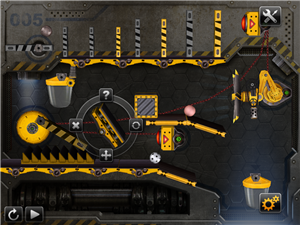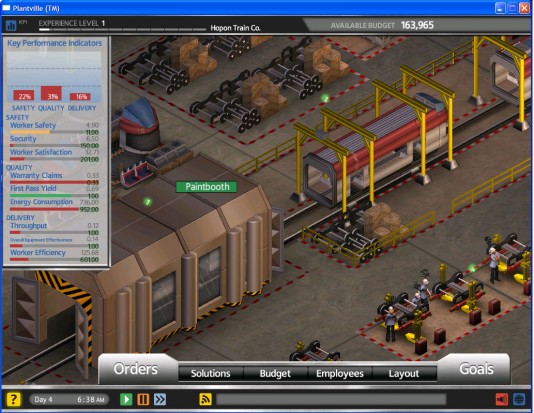Games for fun or insight are the next intersection of social technology and graphics.
By Kathleen Maher
Has gamification gone too far? Lately it’s all anyone has to talk about. The social networking mania has fostered a renewed interest in creating marketing or educational content that functions as a game. One theory out there promulgated by several theorists is that humans might even be coerced into becoming better people if given challenged to behave well and given points when they do.
Yes, it’s a long shot.
On the other hand, games are a good way to learn and points can still be a fine motivator. At the recent COFES conference, the subject of game technology and CAD was discussed from many different angles, but clearly the CAD companies are taking a hard look at game technology for their own purposes. Just recently Autodesk introduced its TinkerBox game for the iOS. It’s a simple educational toy that lets players create Rube Goldberg systems of belts, levers, pulleys, bouncing balls, and tilting cups and demonstrates the cause and effects of physical forces. [Editor’s Note: See also the GraphicSpeak article, “Autodesk gives TinkerBox to the kids.”]

More recently, Siemens Industry, introduced its new Plantville game that casts players as a plant manager and challenges them to keep the plant running and healthy. [Editor’s Note: See also the GraphicSpeak article, “Siemens Industry online game seeks to make manufacturing cool again.”]
Players have to maintain the operation of their plant while trying to improve the productivity, efficiency, sustainability, and overall health of their facility. It’s primarily a marketing tool to demonstrate what can be done with plant management technology. Plantville was created on commission by Pipeworks, the Eugene, Oregon-based division of Foundation9, a 600-person game and animation studio with several offices across the globe. The studio primarily used Autodesk 3ds Max to create characters and objects, then ported content into a proprietary game engine to create the final product.
Siemens Industry is a separate division from Siemens PLM Software, but the two groups are closely related and they are dealing with similar problems. One of the biggest challenges facing the plant industry is the aging of the community right along with the plants themselves. Siemens is hoping to recruit a new generation of people interested in designing, building, and running plants. The game introduces players to Pete, an award-winning plant manager who shares his tips for best practices to help players learn what’s involved in plant management. The game includes Webisodes, the Plantville Café, Puzzlers, and also Facebook, LinkedIn, and Twitter accounts for updates, hints, and news.

Autodesk has played around with consumer technology and games before, but the results never really gave much back to the company. Though some of the attempts were interesting, including a game based on James Gliek’s book Chaos (which let users create their own fractal art), and Animator, (a really fun 2D animation tool), it wasn’t until the iPad came along that Autodesk uncovered a tidy little money pot in the Sketchbook tools.
Just doing something on an iPad makes it more fun—at least so far. Siemens has created the Teamcenter Mobility application for the iPad that even makes PLM fun. [Editor’s Note: See also the GraphicSpeak article, “Siemens PLM launches Teamcenter Mobility for iPad.”]
Dassault Systemes is probably the company that has committed itself most enthusiastically to exploiting game technology for serious work. The company acquired game developer Virtools, which become the core of its 3DVIA division.
Dassault has fostered that division’s game development work and has also incorporated some elements of game design into its CAD products. (To be fair, we’re seeing similar elements evolve in Siemens’ NX software as well. There are knobs and cranks that reveal more information in a satisfying way.)
Dassault’s Bernard Charlés has always said his ultimate goal is to go directly to the consumer. The company’s 3DVIA Shape is a fine example of the way the company is thinking. Shape is similar to Google SketchUp. It’s a free 3D modeling tool that supports touch input to enable what the company calls “finger modeling.” It’s mostly cloud-based, but it has an off-line mode. It also supports anaglyph 3D picture export. The idea is to create, share, and show off 3D models. The software has not come to the iPad yet, but that seems to be on the company’s road map.
A video from Dassault Systemes showing how to use 3DVIA Shape for maps with Microsoft Bing search engine and maps. (Video courtesy Dassault Systemes)
What do we think
This idea of gamification is all over the place but it doesn’t mean the same thing to everyone. Plantville bears an obvious debt to Farmville but it has a practical goal. It wants to teach people what’s involved in plant management. In that it’s timely. The nightmare of Japan’s battle to contain the damage from its nuclear plants is a lesson in how serious the games we’re playing really are. One of the lessons we’ve learned from Fukushima was that plant designers failed to imagine the worst that could happen.
They just didn’t think about the triple whammy of an earthquake, a tsunami, and a power failure. (Though in the event, it is hard to see why a scenario like that wasn’t obvious.) More game play, what-if visualization, and role playing needs to become a larger part of design. Obviously, people are doing this now, but improvements in technology will remove more restraints.
That’s one side of the coin. The other side of the coin is the idea to employ simple, fun, visual games like Tinkerbox and Plantville to demonstrate complex ideas. Around here we say, do the hard stuff.
Well, there is nothing wrong with making hard stuff fun.– K.M.





